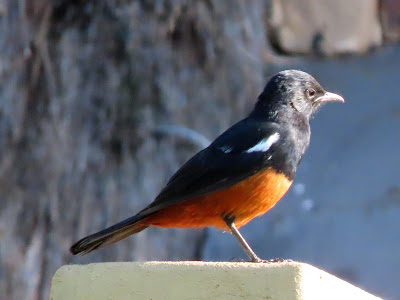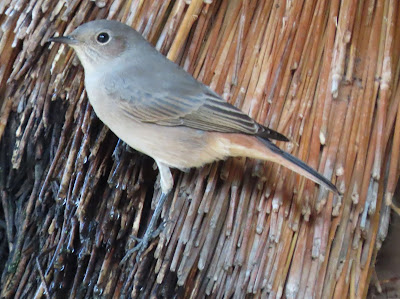One thing Hlalanathi has by the bucket load are bloodsuckers of a type that I've never experienced before. They're minute, silent and deliver bites that itch for days. In an effort to get away from them I often drove away from the camp and parked off to do a crossword or some such. On one of these jaunts, the clouds caught fire as the sun set behind the amphitheatre.
On yet another rainy day, I came across this pied starling whose look matched my mood.
Very pleasing to see reasonable numbers of Amur falcons around, but difficult to imagine the numbers that are slaughtered in India every year as they pass through on their migration.
A morning walk around the golf course turned up a common Hottentot skipper visiting a very pink ipomea.
The resort has numbers of cottages whose roofs are visited by noisy mocking cliff chats........
...............and Cape rock thrush, but only the female allowed her picture to be taken.......
........while the eaves are perfect nest sites for swallows and swifts. By some miracle I managed to snap a white-rumped swift on the wing as it slowed to enter it's home.
The extensive lawns are patrolled by Cape wagtails.........
.......the flower beds provide nectar for gaudy double-collared sunbirds among others.......
........and even the normally secretive Cape robin showed itself.
There were two well fed little cats that were very friendly and loved nothing better than a stroke or tickle and this one went into orgasmic raptures when touched ......but don't go near the tum!
I was sitting in a haze of citronella one afternoon and heard a harsh churring followed by loud knocking which turned out to be a black-backed puffback attacking its reflection in a window. Even without the red eye he'd look manic!
The Royal Natal NR is just up the road and on a visit for a walk, I happened on this quite tame, female bushbuck...........
.....................and a skittish common duiker near the dam.
I then drove up to Mahai parking and as I stopped was set upon by this Cape batis who took great exception to his reflection in the windscreen - the face says it all.
It was a pleasant amble up the valley to the Cascades, which were living up to their name.......
......and on the way back I found this beauty, which I'm told is a mountain malachite damselfly.
A little further up another fall was positively gushing..........................
.................and on the way back this magnificent black-winged kite allowed me to take it's portrait. That is not a normal posture by the way, they bob their tail when they get edgy and are preparing for flight.
Down the road a ways a rufous-naped lark was busy replying to everyone same-to-you, same-to-you!
Another visit to Spionkop Dam to continue atlassing allowed me to get some fairly good pictures of a black-crowned tchagra, who was belting out his beautiful call from the top an acacia.
Across the dam is the hill where the British took an awful thumping from the Boers in 1900 and the Kop at Liverpool's Anfield football ground is apparently named in memory the fallen.
Nearby lurked a murder of crows, a collective noun that's only ever been used by poets and fanciful loons. Always imagine some learned idiot, with nothing better to do, making up these things.
On the road between Winterton and Ladysmith, a sight I've never personally witnessed - Spionkop Dam spilling.
Back at Hlalanathi the clouds draped over the mountains looked like snow.
A familiar chat had a nest under the eaves of one of the cottages and posed perfectly before disappearing in to it. The name came about because they are usually fairly confiding and their predilection for the lard that the Boers greased their axles with, lead to the Afrikaans moniker spekvreter (fat eater).
The original farmhouse on the property is walled but low enough for a nosy fellow to peer over. An amazing collection of bonsai belonging to the owner.
Just had to take this, an African hoopoe looking for breakfast. Might have mentioned it before but it is probably the only bird in South Africa whose English, Afrikaans and scientific names are all derived from it's call. Hence hoopoe, hoephoep and Upupa africana.
Give a child a box of crayons and ask him or her to draw the most colourful bird imaginable and I doubt they'd come up with anything close to those on a white-fronted bee-eater.
Reminiscent of our drill sergeant in the air-force was this ram-rod groundscraper thrush, which is not a misnomer as when they run, they crouch and almost scrape the ground.

































No comments:
Post a Comment